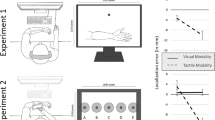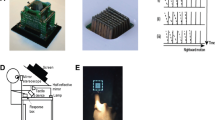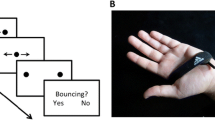Abstract
We adapted the crossmodal dynamic capture task to investigate the modulation of visuotactile crossmodal integration by unimodal visual perceptual grouping. The influence of finger posture on this interaction was also explored. Participants were required to judge the direction of a tactile apparent motion stream (moving either to the left or to the right) presented to their crossed or uncrossed index fingers. The participants were instructed to ignore a distracting visual apparent motion stream, comprised of either 2 or 6 lights presented concurrently with the tactile stimuli. More crossmodal dynamic capture of the direction of the tactile apparent motion stream by the visual apparent motion stream was observed in the 2-lights condition than in the 6-lights condition. This interaction was not modulated by finger posture. These results suggest that visual intramodal perceptual grouping constrains the crossmodal binding of visual and tactile apparent motion information, irrespective of finger posture.



Similar content being viewed by others
Notes
It should be noted that physical synchrony does not necessarily correspond to perceptual synchrony. Although the visuotactile stimuli used in our study were temporally coincident upon presentation, the processing time taken for visual and tactile cues presented on the body surface to reach the brain differs significantly (e.g., Harrar and Harris 2005; Spence and Squire 2003). However, a recent study by Harrar and Harris apparently demonstrated complete compensation for the difference in processing times when simultaneous visual and tactile information were presented on the hand, so that simultaneity was veridically perceived, reflecting, they argued, “a form of simultaneity constancy”. The subjective reports of participants in the pilot trials of the present experiment were also of perceptual synchrony between the central pairings of visuotactile stimuli.
We also analysed the logarithmically transformed accuracy data in order to address the concern that the use of direct proportion scores in parametric statistical tests may lead to an overestimation of significance values in certain situations, due to the artificially reduced variability found when accuracy scores fall close to 0 or 1 (see Sanabria et al. 2005a, b). However, in the present study, the pattern of statistical results obtained using the transformed data was identical to that derived from the untransformed accuracy data. Therefore, for ease of understanding, the data in the text and figures is described in terms of percentages of correct responses.
References
Calvert GA, Spence C, Stein BE (eds) (2004) The handbook of multisensory processes. MIT Press, Cambridge
Craig JC (2003) The effect of hand position and pattern motion on temporal order judgments. Percept Psychophys 65:779–788
Driver J, Spence C (1998) Attention and the crossmodal construction of space. Trends Cogn Sci 2:254–262
Ernst MO, Banks MS (2002) Humans integrate visual and haptic information in a statistically optimal fashion. Nature 415:429–433
Gallace A, Spence C (2005) Visual capture of apparent limb position influences tactile temporal order judgments. Neurosci Lett 379:63–68
Haggard P, Kitadono K, Press C, Taylor-Clarke M (2006) The brain’s fingers and hands. Exp Brain Res. DOI 10.1007/s00221-005-0311-8
Harrar V, Harris L (2005) Simultaneity constancy: Detecting events with touch and vision. Exp Brain Res 166:465–473
Kim DH, Cruse H (2001) Two kinds of body representation are used to control hand movements following tactile stimulation. Exp Brain Res 139:76–91
Kitazawa S (2002) Where conscious sensation takes place. Consciou Cogn 11:475–477
Kitagawa N, Ichihara S (2002) Hearing visual motion in depth. Nature 416:172–174
Klein R (1977) Attention and visual dominance. J Exp Psychol Hum Percept Perform 3:365–378
Ladavas E, Farnè A (2004) Neuropsychological evidence for multimodal representations of space near specific body parts. In: Spence C, Driver J (eds) Crossmodal space and crossmodal attention. Oxford University Press, Oxford pp 69–98
Meyer GF, Wuerger SM (2001) Crossmodal integration of auditory and visual motion signals. Neuroreport 12:2557–2560
Pomerantz JR (1981) Perceptual organization in information processing. In: Kubovy M, Pomerantz JR (eds) Perceptual organization. Erlbaum, Hillsdale, pp 279–330
Sanabria D, Soto-Faraco S, Chan JS, Spence C (2004a) When does visual perceptual grouping affect multisensory integration? Cogn Affect Behav Neurosci 4:218–229
Sanabria D, Soto-Faraco S, Chan JS, Spence C (2005a) Intramodal perceptual grouping modulates multisensory integration: Evidence from the crossmodal dynamic capture task. Neurosci Lett 377:59–64
Sanabria D, Soto-Faraco S, Spence C (2004b) Exploring the role of visual perceptual grouping on the audiovisual integration of motion. NeuroReport 15:2745–2749
Sanabria D, Soto-Faraco S, Spence C (2005b) Spatiotemporal interactions between audition and touch depend on hand posture. Exp Brain Res 165:505–514
Sanabria D, Spence C, Soto-Faraco S (2006) Perceptual and decisional contributions to audiovisual interactions in the perception of motion: A signal detection study. Cognition. DOI 10.1016/j.cognition.2006.01.003
Schneider W, Eschman A, Zuccolotto A (2002a) E-Prime user’s guide. Psychology Software Tools Inc, Pittsburgh
Schneider W, Eschman A, Zuccolotto A (2002b) E-Prime reference guide. Psychology Software Tools Inc, Pittsburgh
Shepard RN (1981) Psychological complementarity. In: Kubovy M, Pomerantz J (eds) Perceptual organization. Erlbaum, Hillsdale, pp 279–330
Shore DI, Spry E, Spence C (2002) Confusing the mind by crossing the hands. Cogn Brain Res 14:153–163
Soto-Faraco S, Kingstone A (2004) Multisensory integration of dynamic information. In: Calvert GA, Spence C, Stein BE (eds) The handbook of multisensory processes. MIT Press, Cambridge, pp 49–67
Soto-Faraco S, Kingstone A, Spence C (2003) Multisensory contributions to the perception of motion. Neuropsychologia 41:1847–1862
Soto-Faraco S, Lyons J, Gazzaniga M, Spence C, Kingstone A (2002) The ventriloquist in motion: Illusory capture of dynamic information across sensory modalities. Cogn Brain Res 14:139–146
Soto-Faraco S, Ronald A, Spence C (2004a) Tactile selective attention and body posture: Assessing the multisensory contributions of vision and proprioception. Percept Psychophys 66:1077–1094
Soto-Faraco S, Spence C, Kingstone A (2004b) Congruency effects between auditory and tactile motion: extending the phenomenon of cross-modal dynamic capture. Cogn Affect Behav Neurosci 4:208–217
Soto-Faraco S, Spence C, Kingstone A (2004c) Crossmodal dynamic capture: Congruency effects of motion perception across sensory modalities. J Exp Psychol Hum Percept Perform 30:330–345
Soto-Faraco S, Spence C, Lloyd D, Kingstone A (2004d) Moving multisensory research along: motion perception across sensory modalities. Curr Dir Psychol Sci 13:29–32
Spence C, Squire SB (2003) Multisensory integration: maintaining the perception of synchrony. Curr Biol 13: R519–R521
Spence C, Squire SB (2005) On the inability to ignore touch when responding to vision in the crossmodal congruency task. Acta Psychol 118:47–70
Spence C, McDonald J, Driver J (2004) Exogenous spatial cuing studies of human crossmodal attention and multisensory integration. In: Spence C, Driver J (eds) Crossmodal space and crossmodal attention. Oxford University Press, Oxford, pp 277–320
Spence C, Sanabria D, Soto-Faraco S (2006) Intersensory Gestalten: assessing the influence of intramodal perceptual grouping on crossmodal interactions. In: Noguchi K (ed) The psychology of beauty and Kansei: New horizons of Gestalt perception (in press)
Welch R (1999) Meaning, attention, and the “unity assumption” in the intersensory bias of spatial and temporal perceptions. In: Ascherlseben G, Bachmann T, Musseler J (eds) Cognitive contributions to the perception of spatial and temporal events. Elsevier, Amsterdam, pp 371–387
Welch R, Warren D (1986) Intersensory interactions. In: Boff K, Kaufman L, Thomas J (eds) Handbook of perception and human performance, vol 1: sensory processes and perception. Wiley, New York, pp 1–36
Yamamoto S, Kitazawa S (2001) Reversal of subjective temporal order due to arm crossing. Nat Neurosci 4:759–765
Yantis S, Nakama T (1998) Visual interactions in the path of apparent motion. Nat Neurosci 1:508–512
Zampini M, Harris C, Spence C (2005) Effect of posture change on tactile perception: Impaired direction discrimination performance with interleaved fingers. Exp Brain Res 166:498–508
Zihl J, von Cramon D, Mai N (1983) Selective disturbance of movement vision after bilateral brain damage. Brain 106:313–340
Acknowledgments
G. Lyons was supported by the University of Melbourne and A.V. was supported by a Newton Abraham Studentship from the Medical Sciences Division, University of Oxford. Correspondence regarding this report should be directed to either Georgina Lyons or Charles Spence, Department of Experimental Psychology, South Parks Road, OX1 3UD, Oxford, UK. E-mail: g.lyons2@ugrad.unimelb.edu.au or charles.spence@psy.ox.ac.uk.
Author information
Authors and Affiliations
Corresponding author
Rights and permissions
About this article
Cite this article
Lyons, G., Sanabria, D., Vatakis, A. et al. The modulation of crossmodal integration by unimodal perceptual grouping: a visuotactile apparent motion study. Exp Brain Res 174, 510–516 (2006). https://doi.org/10.1007/s00221-006-0485-8
Received:
Accepted:
Published:
Issue Date:
DOI: https://doi.org/10.1007/s00221-006-0485-8




